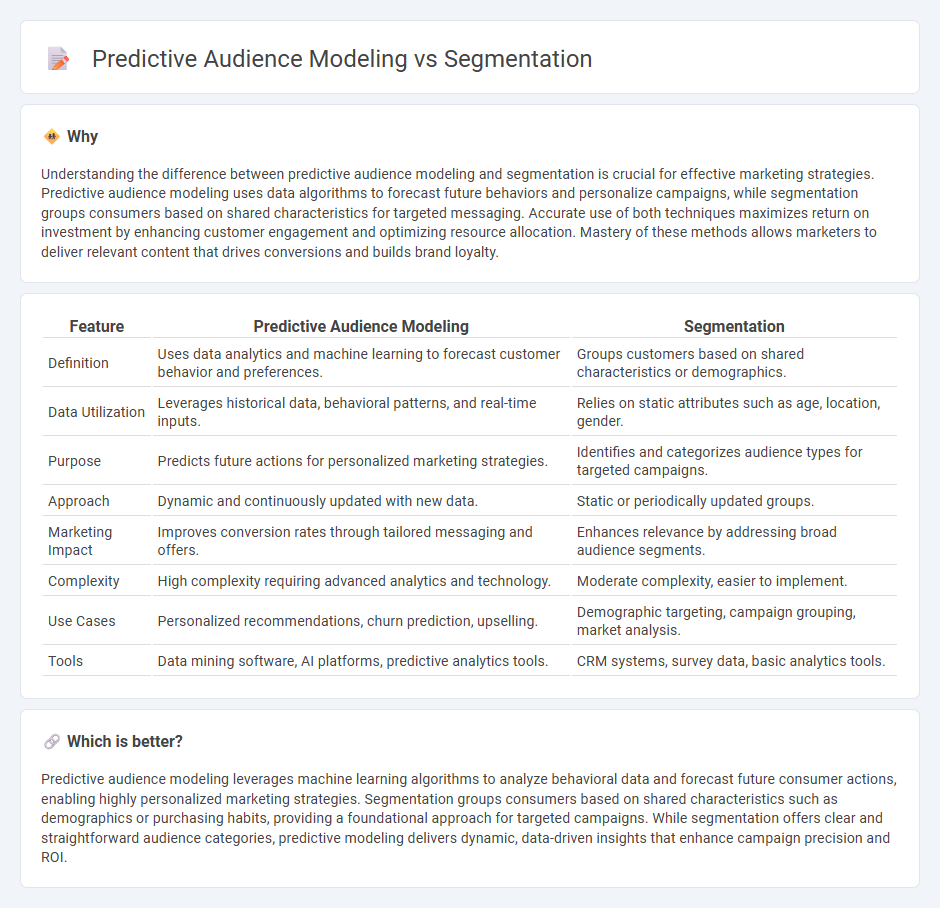
Predictive audience modeling leverages machine learning algorithms to analyze consumer data and forecast future behaviors, enabling more precise targeting compared to traditional segmentation that groups audiences based on static demographics or behaviors. This approach increases marketing efficiency by anticipating customer needs and personalizing campaigns in real-time. Explore how integrating predictive audience modeling can transform your marketing strategies for improved ROI.
Why it is important
Understanding the difference between predictive audience modeling and segmentation is crucial for effective marketing strategies. Predictive audience modeling uses data algorithms to forecast future behaviors and personalize campaigns, while segmentation groups consumers based on shared characteristics for targeted messaging. Accurate use of both techniques maximizes return on investment by enhancing customer engagement and optimizing resource allocation. Mastery of these methods allows marketers to deliver relevant content that drives conversions and builds brand loyalty.
Comparison Table
| Feature | Predictive Audience Modeling | Segmentation |
|---|---|---|
| Definition | Uses data analytics and machine learning to forecast customer behavior and preferences. | Groups customers based on shared characteristics or demographics. |
| Data Utilization | Leverages historical data, behavioral patterns, and real-time inputs. | Relies on static attributes such as age, location, gender. |
| Purpose | Predicts future actions for personalized marketing strategies. | Identifies and categorizes audience types for targeted campaigns. |
| Approach | Dynamic and continuously updated with new data. | Static or periodically updated groups. |
| Marketing Impact | Improves conversion rates through tailored messaging and offers. | Enhances relevance by addressing broad audience segments. |
| Complexity | High complexity requiring advanced analytics and technology. | Moderate complexity, easier to implement. |
| Use Cases | Personalized recommendations, churn prediction, upselling. | Demographic targeting, campaign grouping, market analysis. |
| Tools | Data mining software, AI platforms, predictive analytics tools. | CRM systems, survey data, basic analytics tools. |
Which is better?
Predictive audience modeling leverages machine learning algorithms to analyze behavioral data and forecast future consumer actions, enabling highly personalized marketing strategies. Segmentation groups consumers based on shared characteristics such as demographics or purchasing habits, providing a foundational approach for targeted campaigns. While segmentation offers clear and straightforward audience categories, predictive modeling delivers dynamic, data-driven insights that enhance campaign precision and ROI.
Connection
Predictive audience modeling uses data analytics and machine learning algorithms to identify patterns and forecast consumer behaviors, enabling precise segmentation of target audiences. This connection allows marketers to create highly personalized campaigns by grouping consumers with similar predicted preferences or purchasing habits. Effective segmentation based on these predictions increases engagement rates, optimizes ad spend, and improves overall marketing ROI.
Key Terms
Demographics
Segmentation divides audiences into distinct groups based on demographics such as age, gender, income, and education, facilitating targeted marketing strategies. Predictive audience modeling uses demographic data combined with behavioral and psychographic factors to forecast future consumer actions and preferences. Explore how integrating these methods can enhance your customer targeting and improve campaign performance.
Lookalike Modeling
Segmentation divides audiences based on shared characteristics such as demographics, behaviors, or interests to create targeted groups, while predictive audience modeling, especially Lookalike Modeling, uses machine learning algorithms to identify new users resembling high-value customers. Lookalike Modeling analyzes existing customer data to predict and expand potential audiences with similar attributes, enhancing marketing efficiency and conversion rates. Explore how leveraging Lookalike Modeling can revolutionize your audience targeting strategy.
Behavioral Data
Behavioral data segmentation classifies consumers based on past interactions, such as purchase history and website activity, enabling targeted marketing strategies tailored to specific user groups. Predictive audience modeling leverages machine learning algorithms to analyze behavioral patterns and forecast future actions, enhancing campaign effectiveness by anticipating consumer needs. Explore in-depth comparisons and practical applications to optimize your marketing approach.
Source and External Links
Market segmentation - Wikipedia - Market segmentation is the process of dividing a consumer or business market into meaningful sub-groups, or segments, based on shared characteristics like needs, interests, or demographics, to help businesses target the most profitable customers effectively.
Mastering Your Market Segmentation Strategy: Tips and Examples - Market segmentation qualifies companies or people into groups that respond similarly to marketing strategies, using approaches like demographic, psychographic, behavioral, and geographic criteria to tailor marketing efforts.
Market Segmentation: Definition, Types, Benefits, & Best Practices - Market segmentation divides a target market into approachable groups defined by demographics, needs, interests, or behaviors, enabling businesses to customize products, sales, and marketing strategies for maximum impact.
 dowidth.com
dowidth.com